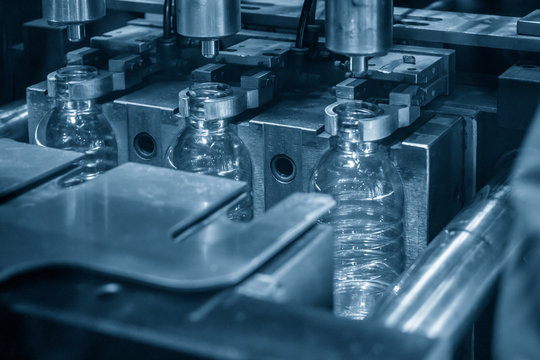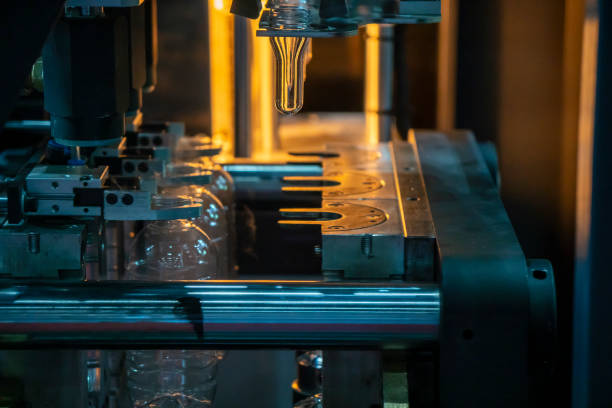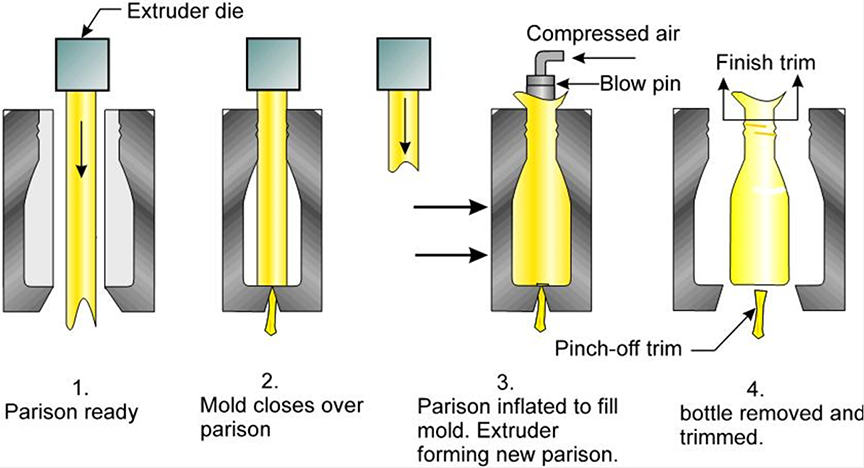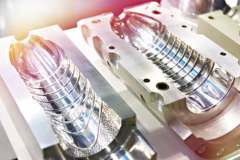Blow molding is a widely used manufacturing technique for creating hollow plastic objects. It involves melting plastic materials and inflating them inside a mold to achieve the desired shape. This process is versatile, producing items like bottles, containers, and toys. With various methods like extrusion, injection, and stretch blow molding, it caters to a range of products. Let’s examine the steps and categories of blow molding in order to enhance our comprehension of how manufacturers produce everyday items!

Blow Molding: What Is It?
Blow molding is a manufacturing process used to create hollow plastic products. In this method, melt and shape a plastic material into a parison, which resembles a hollow tube-like shape. Then, insert the parison into a mold, and blow air into it to expand and shape it against the inner walls of the mold.
This process creates a wide range of products, from bottles and containers to automotive parts and toys. It’s efficient and cost-effective for producing large quantities of plastic items. Blow molding comes in various forms, including extrusion blow molding and injection blow molding.
This technique is widely used due to its versatility, speed, and the ability to produce complex shapes. Whether it’s your water bottle or a shampoo container, many of the plastic items you use are likely created through blow molding.
How Does Blow Molding Work?
Here’s a breakdown of how blow molding works:
Melt the Plastic: The process initiates by melting plastic pellets until they transform into a malleable, uniform liquid.
Form the Parison: Extrude the melted plastic to shape a hollow tube-like form referred to as a parison.
Position the Parison: Place the parison within a mold that possesses the desired shape of the final product.
Blow Air: Blow air into the parison, inducing it to expand and adopt the mold’s interior shape.
Cool and Solidify: Once the plastic takes the mold’s shape, cool it down to solidify.
Eject the Product: Open the mold, and eject the freshly formed product, unveiling the final item.
Trim and Finish: Trim away any excess plastic, called flash, and apply finishing touches.
Verify Quality: Subject each product to quality control to ensure it aligns with the required standards.
Package: Package and prepare the finished products for distribution.

Different types of Blow Molding
Let’s look into the details of each type of blow molding process:
Extrusion Blow Molding:
This method starts by melting plastic resin and then extruding it into a hollow tube-like shape called a parison. Then, clamp the parison into a mold, and blow air into it, compelling the plastic to adopt the mold’s shape. This is commonly used for producing bottles, containers, and drums.
Injection Blow Molding:
In this process, a preform, which is a small plastic piece, is injection molded. The preform is then transferred to a blow mold, where it’s inflated with air to take the desired shape. This method is often used for small and intricate containers, like pharmaceutical bottles.
Stretch Blow Molding:
Typically used for PET (polyethylene terephthalate) bottles, this technique involves first injection molding a preform. The perform is then reheated and placed in a blow mold. A stretch rod elongates the preform while high-pressure air inflates it, resulting in a container with excellent clarity and strength.
Reheat Blow Molding:
Similar to stretch blow molding, this process reheat-stretches a preform before blowing it into the mold. It’s commonly used for making bottles with specific neck finishes and complex shapes.
Accumulation Blow Molding:
Here, plastic is continuously extruded to form a tube that accumulates. Once you achieve the desired length, a mold closes around the tube, and you blow air into it to shape the plastic. This method is suitable for larger items like tanks and containers.
Injection Stretch Blow Molding:
Combining aspects of injection molding and stretch blow molding, this technique produces intricate shapes with precise neck finishes. It begins by injection molding a preform, then reheat and stretch it before blowing it into the final shape.
Multi-Layer Blow Molding:
This process involves creating containers with multiple layers of plastic. These layers might have different properties, such as barrier protection or UV resistance, providing better preservation for products like beverages or chemicals.
Co-Extrusion Blow Molding:
In this process, extrude two or more different plastic materials simultaneously to form a container with distinct layers or patterns. This can enhance aesthetics, functionality, and cost-efficiency.
Rotational Blow Molding:
Primarily used for large, hollow items like tanks, kayaks, and playground equipment, this method rotates the mold during the process. Add molten plastic to the mold, and utilize centrifugal force to evenly distribute it, yielding a uniform wall thickness.
Continuous Extrusion Blow Molding:
This ongoing process serves to create items such as pipes, hoses, and tubing. Molten plastic is continuously extruded through a mold, and a cooling system helps the plastic solidify into the desired shape.
What is blow molding process?
Let’s delve deeper into the blow molding process, step by step:
Melt Plastic: To initiate the process, heat plastic pellets, often made from materials like HDPE (high-density polyethylene) or PET (polyethylene terephthalate), until they transform into molten liquid. This action usually occurs within an extruder.
Shape Parison: Next, shape the molten plastic into a parison, a hollow tube-like structure. You can accomplish this using various methods, including extrusion or injection molding.
Secure in Mold: Position the parison within a mold, a meticulously crafted tool outlining the final product’s shape. The mold consists of two halves that can clamp together.
Inject Air: Inject high-pressure air into the parison. This pressurized air compels the plastic to adopt the mold’s shape, stretching it outward and ensuring thorough contour filling.
Cool Down: Rapidly cool the plastic once it assumes the mold’s shape. Achieve this by circulating cool air or water through the mold. Rapid cooling swiftly solidifies the plastic and retains its shape.
Open the Mold: After the plastic cools and solidifies, open the mold. This exposes the recently formed plastic object inside, still connected to the machine via a slender part known as the “neck” or “tail.”
Trim Excess: Trim away the excess plastic, called flash, formed at the mold’s halves junction. This step guarantees a tidy and refined final product.
Final Result: What remains post-trimming is the completed plastic item – a bottle, container, or another shape – bearing its distinct design, features, and functionalities.

FAQs
What exactly is blow molding?
Blow molding involves a manufacturing process in which molten plastic takes shape as hollow objects through inflating it inside a mold.
How does extrusion blow molding differ from injection blow molding?
In extrusion, shape plastic into a parison before inflating, while injection begins with a preform, rendering it versatile for different shapes.

